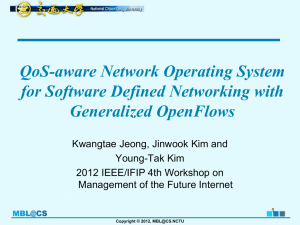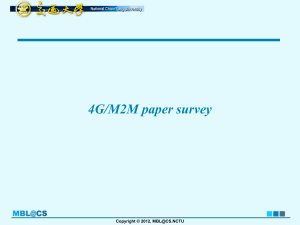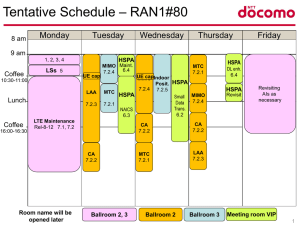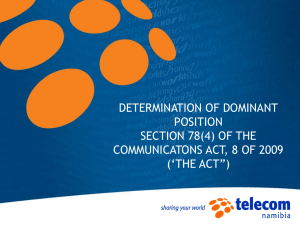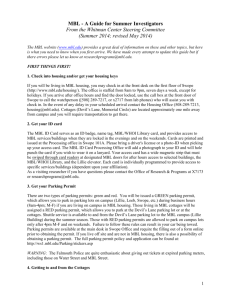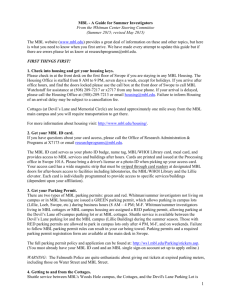Proposed Design
advertisement
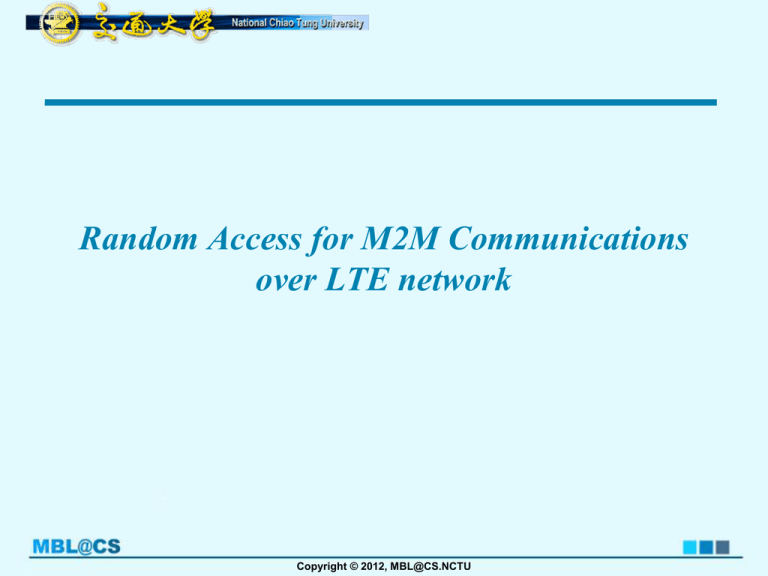
Random Access for M2M Communications
over LTE network
Copyright © 2012, MBL@CS.NCTU
Outline
•
•
•
•
Problem Statement
Related work
Proposed Design
References
Copyright © 2012, MBL@CS.NCTU
Problem Statement
• To enable full mechanical automation where each smart
device can play multiple roles among sensor, decision maker,
and action executor, it is essential to construct scrupulous
connections among all devices [1]
• In the literature, few realizations of M2M communications
have been proposed, such as leveraging Bluetooth (IEEE
802.15.1), Zigbee (IEEE 802.15.4), or WiFi (IEEE 802.11b)
technology. However, there is still no consensus on the
network architecture of a general scenario for M2M
communications [1]
Copyright © 2012, MBL@CS.NCTU
Problem Statement
• It is one of the key issues in the 4-th generation (4G) cellular
networks how to efficiently handle the heavy random access
(RA) load caused by newly accommodating the huge
population of Machine-to-Machine or Machine-Type
Communication (M2M or MTC) customers/devices [2]
• Supporting trillions of devices is the critical challenge in
machine-to-machine (M2M) communications, which results
in severe congestions in random access channels of cellular
systems that have been recognized as promising scenarios
enabling M2M communications [3]
Copyright © 2012, MBL@CS.NCTU
Related Work
Design focus/improvements
UE mixed with MTC
Grouping-based radio
resource management [1]
MTC devices are grouped to
guarantee the QoS requirement
Yes
ABC [2]
Using different combination of H2H
and M2M’s preamble testify the
system’s performance
Yes
Cooperative ACB [3]
Minimize the maximum number of
access among M BSs
No
Proposed design
1. Balance the number of access
among M BSs
2. MTC will not interfere UE
during random access procedure
3. MTC devices are grouped to
reduce the random access delay
Yes
Copyright © 2012, MBL@CS.NCTU
Proposed Design
• Problem formulation [3]
Consider the random access of M2M communications in
LTE-Advanced with 𝑀 BSs indexed by 𝑚 = 1, . . .,𝑀 and
𝑁 active MTC devices indexed by 𝑛 = 1, . . .,𝑁
Distinct from the ordinary ACB that each MTC device
can only access the BS attached by the MTC device, in
this letter, we propose that an MTC device is able to
access the BS unattached by the MTC device when the
MTC device locates within the overlapped coverage area
of multiple BSs
Copyright © 2012, MBL@CS.NCTU
Proposed Design
To formulate such a random access problem, we adopt
following notations
1) Denote 𝐴𝑚 as the set of MTC devices attaching to
the𝑚th BS and ∥𝐴𝑚∥ as the norm of 𝐴𝑚.
When cooperation of BSs are available, 𝐴𝑚 for all
M
m are known by all BSs. Note that
A
N
m 1
Copyright © 2012, MBL@CS.NCTU
m
Proposed Design
2) Denote 𝑀𝑛 as the set of BSs that the 𝑛th MTC
device can possibly access. The 𝑛th MTC device
selects one BS from 𝑀𝑛 to proceed to the random
access. In LTE-Advanced, the BS can request the
MTC device to perform the exploration of
surrounding BSs, and report the exploration result.
Thus, 𝑀 𝑛 for all 𝑛 are available for all BSs.
However, 𝑀𝑛 for 𝑛 = 1, . . .,𝑁, 𝑛 != 𝑗 are unknown
by the 𝑗th MTC device for 𝑗 = 1, . . .,𝑁.
Copyright © 2012, MBL@CS.NCTU
Proposed Design
3) Denote 𝑁𝑚 as the set of MTC devices that access
the 𝑚th BS. In the ordinary ACB,∥𝑁𝑚∥for all 𝑚 are
known by each BS. However, if each MTC device
can access the BS unattached by the MTC device, ∥
𝑁𝑚∥for all 𝑚 are random variables unknown by
BSs, unless the BS selection strategy of each MTC
device is given
4) Denote l𝑛,𝑚 as an indicator function that, for the
𝑛th MTC device,
1, if the mth BS is within M
l n , m 0 , otherwise
Copyright © 2012, MBL@CS.NCTU
n
(1)
Proposed Design
5) Denote 𝑁′𝑚 as the set of MTC devices that can only
receive the signal from the 𝑚th BS and these MTC
devices can only access the 𝑚th BS. ∥𝑁′𝑚∥ is the
norm of 𝑁′𝑚
Copyright © 2012, MBL@CS.NCTU
Proposed Design
Copyright © 2012, MBL@CS.NCTU
Proposed Design
In the ordinary ACB, although the throughput of each
cell can be individually maximized by individually
setting p𝑚 = 1/∥𝑁𝑚∥ (where p𝑚 is the ACB parameter
of the the 𝑚th BS) in each BS, the delay experienced by
an MTC device attached to the 𝑚 th BS may be
unacceptable when 𝑝𝑚 requires to be set to an extremely
small value under a large ∥𝑁𝑚∥
our objective is to provide an optimum control of a set of
ACB parameters p = [𝑝1, . . . , 𝑝𝑀] jointly decided by 𝑀
BSs to minimize the largest access delay experienced
among 𝑁 active MTC devices
Copyright © 2012, MBL@CS.NCTU
Proposed Design
Through cooperation among BSs to make a joint decision
of p = [𝑝1, . . . , 𝑝𝑀], the problem can be formulated by
min
p 1,..., pM
balance ( N 1 , N 2 ,..., N M )
s .t . C 1 . 1 0 p p1 ,..., p M 1
C2.2
N m p m 1, for m 1,..., M
Copyright © 2012, MBL@CS.NCTU
(2)
Proposed Design
• BS selection strategy for each MTC device
BS selection strategy is based on pm, for m=1,…,M (BS
with higher pm has higher probability to be accessed by
MTC)
Upon receiving ˜p𝑛 = {𝑝𝑖, 𝑝𝑗, . . . , 𝑝𝑘} ⊆ p, the 𝑛th
MTC device adopts the strategy
n p i ,..., p k
Q n ,i
pi
x M
px
y M
Ay
,..., Q n , k
n
Ai
n
Ai Ai 1, Ai 0 , i M n
pk
x M
px
n
y M
Ak
n
Ay
(3)
where 𝑄𝑛,𝑥 is the probability that the 𝑛th MTC device
selects the 𝑥th BS to access
Copyright © 2012, MBL@CS.NCTU
Proposed Design
• Cooperative Access Class Barring
Given that the strategy on the selection of the BS in each
MTC device in (3) is known by BSs, ∥𝑁𝑚∥ for all 𝑚 can
be obtained by
M
Nm
l
n , m Q n , m for m 1,..., M
(4)
x 1 n A x
The optimal p can be found by algorithm 1 and algorithm
2 proposed by [3]
Copyright © 2012, MBL@CS.NCTU
Proposed Design
eNB
MTC
System Information
(SIB2,P) via broadcast
Access Barring Check
Draw a random
number-unif(0,1)
Retry after a
certain period
Number <
ac-Barringfactor
No
Yes
Access Class Barring
Draw a random
number
q-unif(0,1)
q<p
No
Yes
Random Access Preamble
Scheduled Transmission
Contention Resolution
Copyright © 2012, MBL@CS.NCTU
Random Access
Random Access Response
Proposed Design
Copyright © 2012, MBL@CS.NCTU
Proposed Design
σi :the random access rate for MTC i
Receiving a service
request from MTC
device carrying σi
Are there enough PRBs in the
AGTI supporting one more MTC
device
No
The eNB Rejects the
MTC request
Yes
Is there a cluster with parameter
σi
No
The eNB creates a new
cluster for the MTC
Yes
The eNB permits the
MTC to join a cluster
Copyright © 2012, MBL@CS.NCTU
王老師的建議
1. 如何更精確反應出每個BS下的情況?
Key paper所提的Qn,i只考量了此round期望能access BS
的 MTC 數,逸懷的方法加入考量每台 BS 實際有 attach 上此
BS的個數,更能反應出目前BS實際loading情況
2. Access Barring Check(ABC)與Access Class Barring(ACB)
的差別?
ABC與ACB都是根據目前BS的loading來調整其threshold,
所以沒有差別
Copyright © 2012, MBL@CS.NCTU
曾老師的建議
1. 可衡量MTC與UE通過Random access的比率
2. MTC 與 UE 在 Random access 時,是共享 or 獨有 Resource
Block(RB)?
目前3GPP spec並沒有針對這部分做規範,但根據survey
paper,目前研究都是假設MTC與UE在Random access時是
共享RB
3. UE及MTC發Random access的頻率?
UE 發完 Random access 與 BS 連上後,就不再發 Random
access
MTC 每次的上傳或是下載前,都要先跟 BS 發 Random
access
Copyright © 2012, MBL@CS.NCTU
References
[1] Shao-Yu Lien; Kwang-Cheng Chen; Yonghua Lin; , "Toward ubiquitous
massive
accesses
in
3GPP
machine-to-machine
communications," Communications Magazine, IEEE , vol.49, no.4, pp.66-74, April
2011
[2] Ki-Dong Lee; Sang Kim; Byung Yi; , "Throughput comparison of random
access methods for M2M service over LTE networks," GLOBECOM Workshops
(GC Wkshps), 2011 IEEE , vol., no., pp.373-377, 5-9 Dec. 2011
[3] Shao-Yu Lien; Tzu-Huan Liau; Ching-Yueh Kao; Kwang-Cheng Chen; ,
"Cooperative
Access
Class
Barring
for
Machine-to-Machine
Communications," Wireless Communications, IEEE Transactions on , vol.11,
no.1, pp.27-32, January 2012
Copyright © 2012, MBL@CS.NCTU

